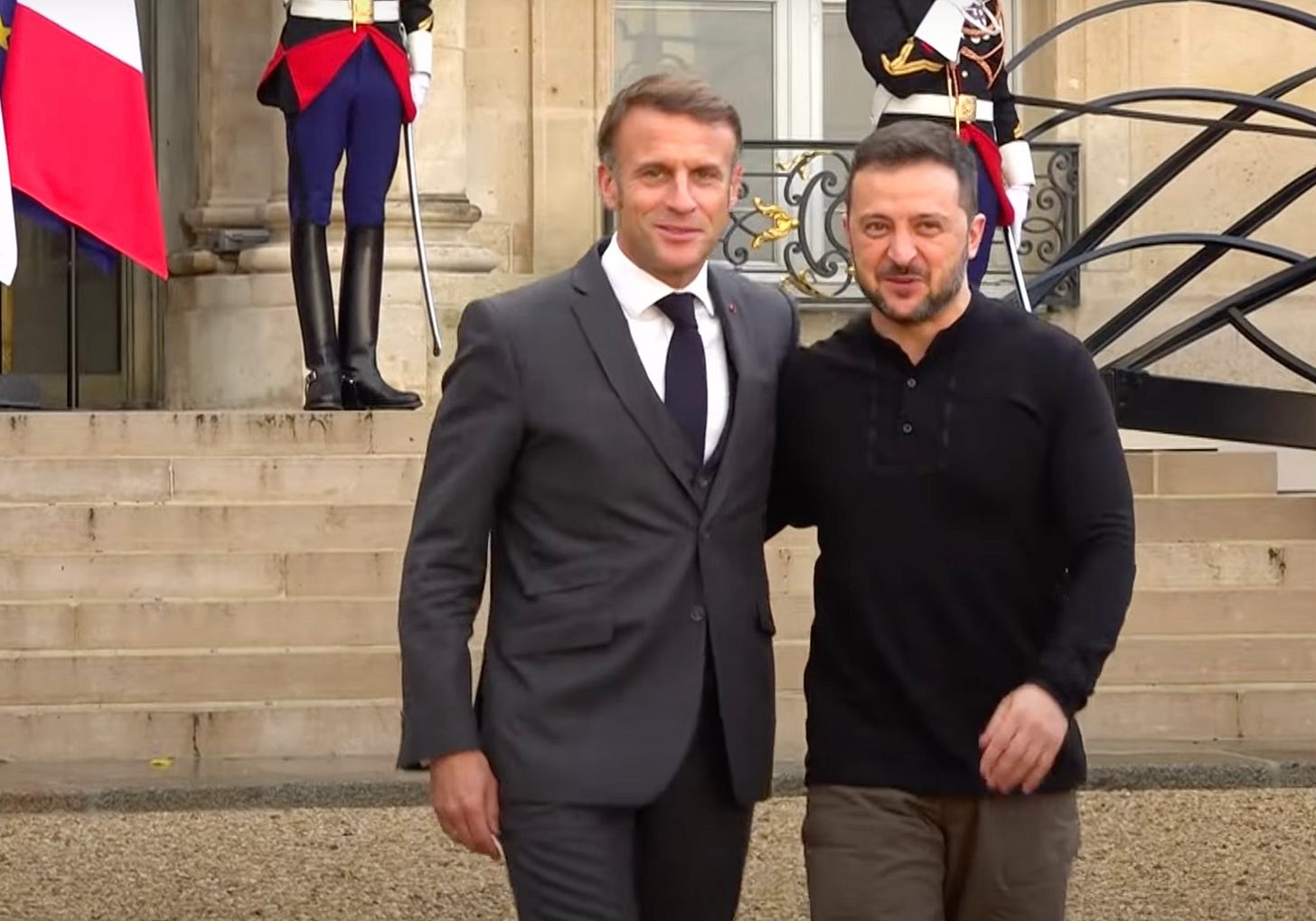What should we take away from the high-stakes summit in Washington, where Donald Trump and Volodymyr Zelensky were joined by a parade of Western leaders—Emmanuel Macron, Britain's Keir Starmer, Italy's Giorgia Meloni, Germany's Friedrich Merz, Finland's Alexander Stubb, NATO Secretary General Mark Rutte, and European Commission President Ursula von der Leyen? In short, the full cavalry showed up to defend Ukraine’s interests—interests that are not necessarily those of “Europe”—with results that remain uncertain at best.
Territorial concessions? The topic wasn’t officially addressed, but the U.S. administration has subtly indicated that it sees them as inevitable.
A ceasefire? That, too, has vanished from the diplomatic conversation. Donald Trump is pushing for a final resolution to the war: a peace deal.
A Putin-Zelensky meeting? Still murky. Europe wants a seat at the table, but Russia firmly rejects the idea.
Security guarantees? Trump has vetoed Ukraine’s NATO membership, and von der Leyen’s talk of offering Kyiv Article 5-equivalent guarantees drifts into fantasy. The Commission President continues to act like a head of state, ignoring the fact that defense policy is outside her remit. In doing so, she adds confusion to an already chaotic picture.
In the end, the only clear takeaway from Washington is this: Europe is once again being played for a fool. It will be left to foot the bill—for a fragmented state resembling Kosovo on steroids. Despite French media narratives, a negotiation clearly took place. That’s made explicit in the video linked above, and further confirmed by the presence of U.S. Treasury Secretary Scott Bessent (third from the left, standing behind J.D. Vance and Marco Rubio).
When asked what the United States would be providing Ukraine, both leaders were blunt:
Donald Trump: “We’re not giving anything—we’re selling weapons.”
Volodymyr Zelensky: “We now have the possibility to purchase weapons from the U.S. We are grateful to Europe, which is financing this through NATO.”
There’s the deal. It was already foreshadowed when the Financial Times reported on a document in which Zelensky proposed a $100 billion arms purchase from the U.S.—to be financed by Europe—in exchange for American security guarantees following a peace agreement with Russia. The story was later picked up by Reuters.
But where is this $100 billion (€90 billion) coming from? From the European Peace Facility (EPF). Since 2022, this off-budget fund, directly managed by the EU Council—not the Commission—and financed through direct contributions from member states, has granted over €11 billion to Ukraine for military equipment and training. With a total EPF budget of €17 billion, we’re still far from the $100 billion mark.
Let’s be clear: the EPF is an arms exchange system, utterly opaque and based on a compensation mechanism that opens the door to all kinds of shady dealings.
Arms sales, military equipment procurement, and supply contracts have long been vulnerable to corruption. Ongoing judicial investigations into the NATO Support and Procurement Agency (NSPA)—the alliance’s central purchasing body—underscore just how corrupt this business can be.
In the meantime, it's far from certain that the numbers will add up for everyone. Last October, the European Court of Auditors sounded the alarm over the financial risks Ukraine poses to the EU budget. But its warnings received little attention—and even less action.
“EU Financial Aid to Ukraine Is Seriously Undermining the Union’s Finances. The Way These Loans Are Structured Makes the European Taxpayer the Biggest Loser,” we wrote back in October 2024.
We are republishing this article today, freely accessible to all.
Europe’s blank check for Ukraine
In October 2024, the European Court of Auditors released a report expressing considerable concern about the EU's finances. The culprits? COVID-19 and the war in Ukraine, both of which are straining the Union's budget. The issue is not so much the amount of aid and loans granted to Ukraine, but how they are being distributed.
The EU is heavily in debt—and alarmingly so. This growing debt is in violation of EU treaties. Between 2022 and 2023, EU debt surged by over 30%, rising from €348 billion to €458.5 billion. It is now twice as high as in 2021.
As the European Court of Auditors put it in its October 9 report, the EU has become “one of the largest debt issuers in Europe.” The inflation crisis is part of the problem, but not the only one. The NextGenerationEU program—entirely financed through debt—has also been a significant factor. In 2023 alone, the post-COVID recovery plan led to more than €268 billion in loans, without any real economic impact.
Altogether, the European Commission plans to borrow €800 billion on capital markets—a sum that will need to be repaid starting in 2027.
How will this be managed? The Court of Auditors is skeptical that the European Commission's proposal to use the Union's own resources will be enough to cover the repayment of this debt. In short, new loans will need to be taken out to repay existing ones, perpetuating the very debt spiral that the Commission criticizes in countries like France, Belgium, and Italy.
Debt servicing is not only about repaying loans but also about paying interest. And this expenditure is rising fast. The cost of servicing EU recovery plan debts has nearly tripled and is expected to hit €42 billion. Siegfried Mureșan, the EU budget rapporteur, has referred to this as a “time bomb” for the EU’s budget.
While the EU’s budget has already been severely strained by the post-COVID recovery plan, financial support for Ukraine is placing an even greater strain on its finances.
In 2023, aid to Ukraine more than doubled, rising from €16 billion to €33.7 billion—out of a total of more than €70 billion, as of June 2023.
There are no guarantees that Ukraine will be able to repay these loans, at least within the agreed timeframes, which could further exacerbate the EU's debt burden. Should Ukraine default, the losses would be absorbed directly by future EU budgets, the Court of Auditors warns. But new instruments introduced in 2024 to aid Kyiv will only add to the financial burden.
This is the Ukraine Facility—not to be confused with the Peace Facility. A program outside military and refugee aid, set to allocate €50 billion until 2027, bringing the total amount of financial support for Ukraine to €200 billion for its reconstruction. This plan was put in place without any impact assessment, neither on Ukraine nor on EU finances. There are no significant conditions attached, except for vague mentions of human rights and democratic mechanisms—forgetting that Zelensky has been an unelected president since 2023. It’s a program with limited oversight, implemented in a country with endemic systemic corruption.
This is not the first warning from the Court of Auditors. In 2023, before the implementation of this mechanism, the auditors had already sounded the alarm in an official opinion.
The €50 billion will be divided into just over €17 billion in non-repayable grants and interest subsidies for Ukraine, and €33 billion in loans contracted on financial markets, backed by the EU’s “flexibility margin”. The terms are highly favorable to Kyiv 1, but much less so for the EU in case of Ukrainian default. And, of course, this burden will fall on EU member states and, ultimately, on the European taxpayer—mainly Germany and France, who are the largest net contributors. If the EU’s remaining budget flexibility fails to cover the costs, there will be no room to maneuver.
As a last resort, the European Commission can request funds from EU member states to service the Union’s debt. In corporate terms, this would be considered organizing a bankruptcy.
In other words, not only is the EU spending on Ukraine, which is not a member state, but it is also incurring debt on behalf of Ukraine—to the detriment of Europeans. This poses an increasingly significant financial risk to the public finances of all member states. As early as 2022, the Court of Auditors had warned about the increased exposure of the EU budget to the situation in Ukraine.
Loans with a maximum maturity of 35 years, with principal repayments not starting until 2034 — accompanied by interest subsidies and coverage of other borrowing costs.



![[ Redux ] Ukraine, Dance Macabre of European Arms](https://substackcdn.com/image/fetch/$s_!bRP3!,w_140,h_140,c_fill,f_auto,q_auto:good,fl_progressive:steep,g_auto/https%3A%2F%2Fbucketeer-e05bbc84-baa3-437e-9518-adb32be77984.s3.amazonaws.com%2Fpublic%2Fimages%2F515d4fba-8f5f-40e4-b332-34eb78afcc68_820x547.jpeg)









